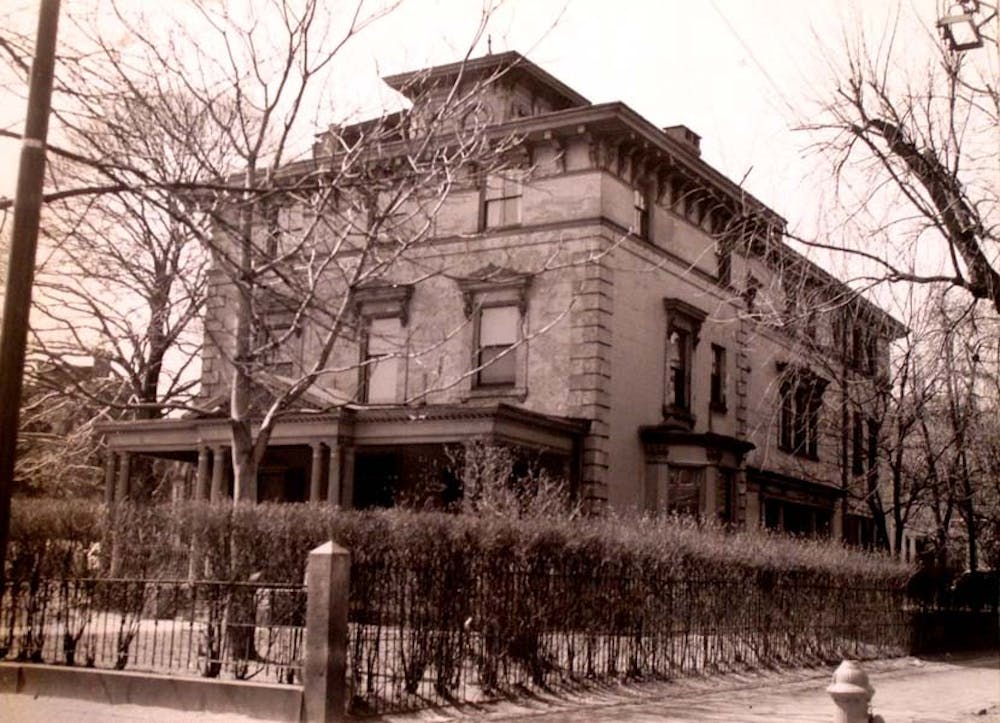
Penn is currently involved in court proceedings over tearing down the historic villa at 400 South 40th Street. There will be another hearing Tuesday.
Penn is in the middle of a long fight in the court system over the potential demolition of a historic landmark on 400 South 40th Street.
The University hopes to turn the site into student housing, but neighbors, preservationists and School of Design students are fighting to keep the building intact. Tuesday will bring another court hearing, when the fate of the villa may finally be sealed.
Since 1973, the villa — which Penn purchased in 2003 — has been listed as a local landmark in two nationally-registered historic districts, the Hamilton Family Estate National Register District and the West Philadelphia Street Car Suburb National Register District.
The villa is historically significant in part because it was designed in the mid-19th century by one of the most famous architects in Philadelphia’s history, Samuel Sloan, who built in the city the 1840s to the 1860s.
“To have a whole cluster of [his houses] intact in one place is really a big deal,” Assistant Professor of Landscape Architecture and Historic Preservation Aaron Wunsch, who is heavily involved in the battle to preserve the villa, said.
Wunsch, who lives in the Woodland Terrace area where the villa stands, got involved in the case about a year ago when Penn announced their demolition plan for the site.
When Penn first purchased the site, the school originally wanted to keep the villa intact and preserve its status as a historical landmark.
In 2007 and 2010, Penn proposed two different construction plans that would have preserved the original building. However, the Woodland Terrace Homeowners Association and the Spruce Hill Community Association, the two neighborhoods where the house stands, disapproved of both proposals. They felt that the proposed structures “were too massive and wide and intrusive,” Wunsch said.
“They were opposed to something being completely out of scale with the neighborhood,” he added. The first proposal involved creating an 11-story building behind the existing villa, while the second proposed a seven-story structure.
After both of the initial proposals were discarded, Penn began to work with a different developer, Equinox Properties, according to Executive Director of Penn’s Facilities and Real Estate Services Ed Datz. Equinox came up with a building option that would involve the complete demolition of the villa in order to build a five-story structure that would satisfy both Penn and the height criteria.
Penn took the plan to the Philadelphia Historical Commission and got permission to demolish the building despite its status as a local landmark.
“There are certain instances when the commission can approve a demolition [of a landmark], but they are very few and far between,” Jonathan Farnham, executive director of the Philadelphia Historical Commission, said.
In this case, the commission found that denying Penn permission to demolish the building “would be violating the Philadelphia and United States constitutions” because the University would not have been able to get value from it, according to Farnham.
Farnham explained that when Penn brought their demolition plan to the Historical Commission, they claimed financial hardship and proved that there was no feasible reuse for the historic building and that they would not make any profit if they kept the building standing.
The Spruce Hill Community Association supported the demolition plan and the construction of the five-story structure, but the Woodland Terrace community objected to the destruction and took Penn and the Historical Commission to court last May to appeal the decision.
Yet the Woodland Terrace Homeowner’s Association is not the only party that disagrees with the Historical Commission’s decision.
Kevin Wohlgemuth and Reina Chano, two first-year students in the historic preservation graduate program at PennDesign, have been working with other students and professors at PennDesign to help the Woodland Terrace Homeowners Association come up with an alternate plan for the building.
“[The Historical Commission] is a great model, but they’ve been really quick to grant financial hardship cases and to not think creatively to help Philadelphia preserve its historic fabric,” Chano said.
Both Chano and Wohlgemuth have been working on an alternative use plan that would allow PennDesign students to use the historic building as a studio for research in conservation, condition assessment and in-site analysis. Their hope is to give students the opportunity to devise their own plan for how to turn the villa into student housing, “which would give Penn what they are looking for,” Wohlgemuth said.
It is unclear how far their plan has reached at Penn. “It’s a slow process,” Wohlgemuth said. “We haven’t brought our proposal to everyone in the University.”
FRES has not yet been approached with any student proposals. “We have not specifically been approached from that direction,” Datz said. “I have not heard of any specific proposals.”
On Tuesday’s court hearing, the materials of the case will be reviewed and a possible finding may be released. However, Datz does not believe a decision will be made.
Despite what happens in court tomorrow, Chano and Wohlgemuth and the Woodland Terrace Homeowners Assocation will continue to fight to appeal any decision that will allow the villa to be torn down.
Wohlgemuth and Chano hope to have more time to promote their plan at Penn.
“We think Philadelphia is historic … this building is a clear example of that and Penn can be a leader in coming up with solutions rather than demolishing the building,” Wohlgemuth said.
The Daily Pennsylvanian is an independent, student-run newspaper. Please consider making a donation to support the coverage that shapes the University. Your generosity ensures a future of strong journalism at Penn.
DonatePlease note All comments are eligible for publication in The Daily Pennsylvanian.







